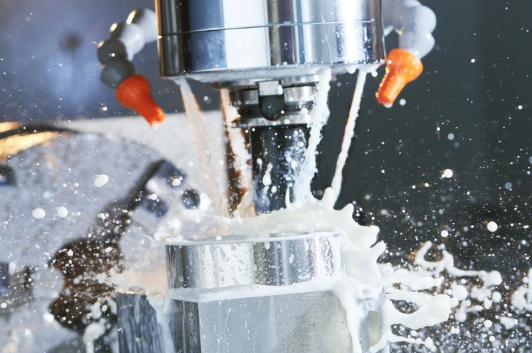Types of Metalworking Fluids
During metal cutting or other metalworking operations, a fluid is often used to lubricate the point of contact between the tool and workpiece, while cooling the tool and workpiece surface to guard against wear and damage.
However, no fluid excels at all the necessary properties for a given operation. Selecting the best metalworking fluid for your application therefore requires more insight, such as an understanding of the different types of fluids, their general compositions, and the properties they tend to exhibit.
In very general terms, the various liquid metalworking fluids contain varying degrees of oil and water content, along with various performance additives. As a base liquid, water is very effective at cooling, but it is a poor lubricant. Mineral oils are the opposite: they are great at lubricating but are not as effective in cooling. You can roughly divide traditional metalworking fluids into these four basic categories:

Straight oils (or mineral oils)
Straight oils are typically petroleum-based oils that often include extreme pressure additives to enhance performance. These fluids are usually used “as received” and are best suited for slower speed, severe operations that require the good lubricity that the base oil provides. Straight oils also effectively prevent rusting of the workpiece.
Soluble (emulsifiable) oils
Soluble oils (or emulsifiable oils) are made with oil and various additives as a concentrate. The concentrate is then then diluted with water before use to make emulsions. The result is a working fluid that appears milky in color. Due to the composition of both oil and water fluids, soluble oils provide both lubrication and cooling, offering well-rounded performance. Soluble oils tend to be some of the more common metalworking fluids.
Synthetic fluids
Synthetic metalworking fluids are predominantly water-based fluids with numerous additives to enhance performance. Only needing dilution with water, these fluids offer excellent cooling and are best suited for high-speed processes where the removal of heat is most critical. Synthetic fluids are clear and also usually provide very low foaming, which is a desirable trait.

Semi-synthetic fluids
A final category is semi-synthetic fluids. As a concentrate, semi-synthetic fluids contain a combination of oil, additives and water. This concentrate is then further diluted with water into the finished fluid. Semi-synthetics appear as more translucent fluids, falling between the clear appearance of straight oils and synthetics and the opaque, milky appearance of soluble oils. Although semi-synthetic fluids are challenging to formulate, they are gaining in popularity due to their optimized balance of lubricating and cooling properties, as well as their clean operation.
Ultimately, the right fluid depends on a range of factors, including the type of workpiece material, the operating speed, the type of operation, the machine tool, the fluid maintenance demands, etc. When the right fluid is properly matched to the operation, the result is better workpiece quality, more efficient processing, better tool life, and better overall fluid maintenance.
See related posts below to learn more: